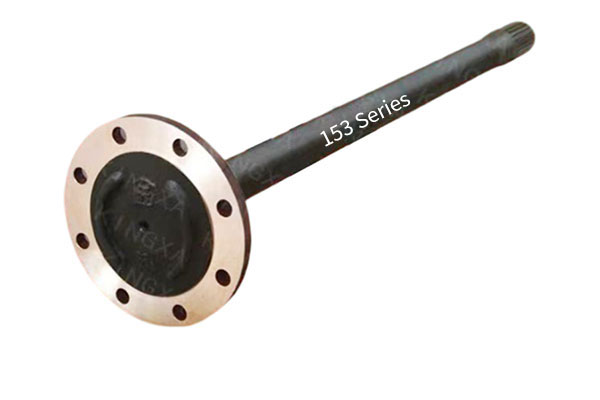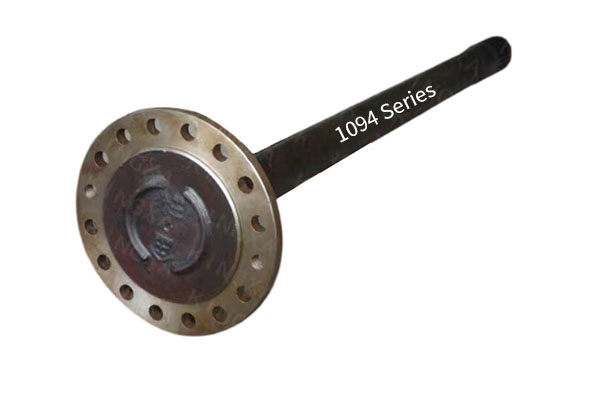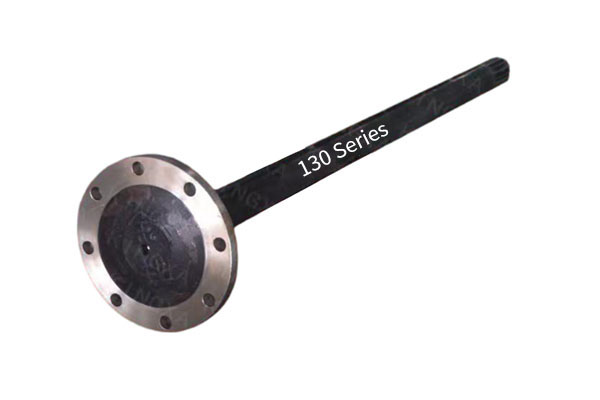What are the key manufacturing processes in the production process of heavy-duty vehicle rear axle half shaft?
Release Time : 2025-01-09
The heavy-duty vehicle rear axle half shaft is an important component in the automobile transmission system. Its manufacturing process involves multiple key manufacturing processes and technologies to ensure that the half shaft has sufficient strength, stability and durability.
First of all, in terms of material selection, the heavy-duty vehicle rear axle half shaft usually uses high-strength alloy steel, such as 40CrNiMoA. These materials have good hardenability and fatigue resistance, and can meet the high-performance requirements of heavy-duty vehicles for half shafts.
In terms of manufacturing process, forging is one of the key steps in the production of heavy-duty vehicle rear axle half shaft. Through forging, the half shaft material can obtain a dense microstructure and improve its mechanical properties. During the forging process, parameters such as heating temperature, forging ratio and cooling rate need to be strictly controlled to ensure that the half shaft obtains an ideal grain structure and streamline distribution.
Next is the heat treatment process, including quenching and tempering. Quenching can improve the hardness and wear resistance of the half shaft, while tempering helps to eliminate the internal stress and brittleness generated during the quenching process and improve the toughness and plasticity of the half shaft. During the heat treatment process, parameters such as heating temperature, holding time and cooling medium need to be precisely controlled to obtain the ideal hardened layer depth and distribution.
In terms of machining, the heavy-duty vehicle rear axle half shaft needs to undergo precise turning, milling and grinding processes to obtain accurate size and shape. These processes need to be carried out on high-precision machine tools to ensure the machining accuracy and surface quality of the half shaft.
In addition, surface treatment technology is also an important link in the manufacturing of heavy-duty vehicle rear axle half shaft. Through surface treatment methods such as shot peening, carburizing, and nitriding, the hardness and wear resistance of the half shaft surface can be improved and its service life can be extended. These surface treatment technologies need to be selected and applied according to the specific use environment and requirements of the half shaft.
Finally, quality inspection and testing are key steps to ensure the quality of heavy-duty vehicle rear axle half shaft. Through non-destructive testing, mechanical properties testing and fatigue testing, the quality of the half shaft can be comprehensively evaluated to ensure that it meets the design requirements and usage standards.
In summary, the production process of heavy-duty vehicle rear axle half shaft involves multiple key manufacturing processes and technologies. By strictly controlling these processes and technical parameters, it can be ensured that the half shaft has excellent mechanical properties and durability to meet the high requirements of heavy-duty vehicles for the transmission system.
First of all, in terms of material selection, the heavy-duty vehicle rear axle half shaft usually uses high-strength alloy steel, such as 40CrNiMoA. These materials have good hardenability and fatigue resistance, and can meet the high-performance requirements of heavy-duty vehicles for half shafts.
In terms of manufacturing process, forging is one of the key steps in the production of heavy-duty vehicle rear axle half shaft. Through forging, the half shaft material can obtain a dense microstructure and improve its mechanical properties. During the forging process, parameters such as heating temperature, forging ratio and cooling rate need to be strictly controlled to ensure that the half shaft obtains an ideal grain structure and streamline distribution.
Next is the heat treatment process, including quenching and tempering. Quenching can improve the hardness and wear resistance of the half shaft, while tempering helps to eliminate the internal stress and brittleness generated during the quenching process and improve the toughness and plasticity of the half shaft. During the heat treatment process, parameters such as heating temperature, holding time and cooling medium need to be precisely controlled to obtain the ideal hardened layer depth and distribution.
In terms of machining, the heavy-duty vehicle rear axle half shaft needs to undergo precise turning, milling and grinding processes to obtain accurate size and shape. These processes need to be carried out on high-precision machine tools to ensure the machining accuracy and surface quality of the half shaft.
In addition, surface treatment technology is also an important link in the manufacturing of heavy-duty vehicle rear axle half shaft. Through surface treatment methods such as shot peening, carburizing, and nitriding, the hardness and wear resistance of the half shaft surface can be improved and its service life can be extended. These surface treatment technologies need to be selected and applied according to the specific use environment and requirements of the half shaft.
Finally, quality inspection and testing are key steps to ensure the quality of heavy-duty vehicle rear axle half shaft. Through non-destructive testing, mechanical properties testing and fatigue testing, the quality of the half shaft can be comprehensively evaluated to ensure that it meets the design requirements and usage standards.
In summary, the production process of heavy-duty vehicle rear axle half shaft involves multiple key manufacturing processes and technologies. By strictly controlling these processes and technical parameters, it can be ensured that the half shaft has excellent mechanical properties and durability to meet the high requirements of heavy-duty vehicles for the transmission system.







